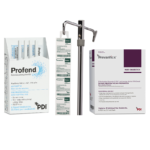Interventional Care


We notice that you are visiting us from . This site only services US-based visitors. Would you like to visit the site that is appropriate for your location?

As of 28 December 2021, the United States has had 52,827,097 cases of COVID-19 leading to 818,395 deaths. COVID-19 cases in the United States are now exceeding greater than 200,000 cases per day; the current level of cases has exceeded those seen during the Delta peak in August-September 2021. Although according to the New York Times, as of January 3rd, 2022, COVID-19 cases have increased by 105%, hospitalizations have increased only 6% and deaths have decreased by 5%.
The dramatic increase in COVID-19 cases worldwide and in the United States is being largely driven by the immergence of the Omicron variant of SARS-CoV-2. SARS-CoV-2 is an enveloped RNA virus. All viruses, but especially RNA viruses, change over time due to mutations (see Table 1 for definitions). The U.S. Centers for Disease Control and Prevention (CDC)1 and the World Health Organization2 classify and track SARS-CoV-2 variants. Variants are categorized as variants of concern (VOC), variants of interest (VOI), or variants of high consequence (VOOHC) (see Table 2). The Omicron variant was first reported from South Africa in November 2021. This variant is now the predominant variant both worldwide and in the United States.
On November 30, 2021, Omicron was designated by the U.S. Government as a variant of concern based on the following:
Omicron is replacing Delta as the dominant variant worldwide for the following reason:
Due to these characteristics, the doubling time of Omicron is ~1.5 to 2.0 days.3 Prior infection with COVID-19 (Delta or a non-Omicron variant) provides limited protection against acquiring Omicron with a risk of reinfection 5.41-fold higher than with Delta.3 There is a significantly higher risk with Omicron than with Delta in persons fully vaccinated (i.e., 2 weeks after completing a complete two-dose series of Pfizer or Moderna) of 2.68-fold.3 However, persons who have had a primary vaccine series plus a booster dose have substantially better protection, 55 to 80% against acquiring Omicron.3
Another study reported that 15 weeks after a two-dose series of Pfizer vaccines, vaccine effectiveness was ~34 to 37% but rose to ~75.% after a booster dose.4 Discovery Health reported that 2 doses of Pfizer vaccine provided 33% protection against infection with Omicron but 70% protection against severe disease.5 Omicron has been associated with a lower rate of hospitalization than Delta.3 One study reported that the overall risk of hospitalization with Omicron was 1.2% compared with 1.5% with Delta.6
Based on in vitro tests, Omicron also is not treatable by most currently available monoclonal antibody therapies. However, Sotrovimab is still effective but likely to be in short supply. Other effective therapies include the new oral drugs Molunpiravir and Paxlovid which are~30% and ~90% effective against serious diseases such as hospitalizations, respectively.7 Remdesivir, an FDA-approved drug, can also be used off-label for therapy of persons with mild to moderate infection who are at high risk for progression to serious disease.7 Evusheld (tixagevimab co-packaged with cilgavimab), a monoclonal antibody combination is FDA authorized for pre-exposure therapy of highly immunocompromised persons; the drug provides protection for 6 months, at which time it can be redosed.7
We should expect that Omicron will become the overwhelming dominant variant worldwide and in the United States by mid-January. Preventive measures include the following:
References: